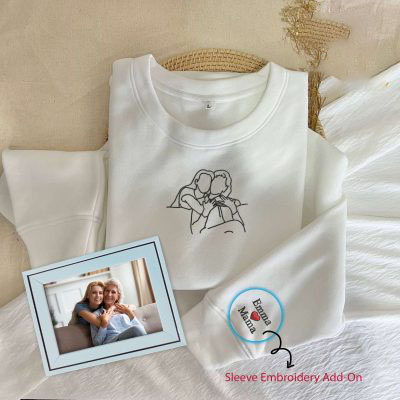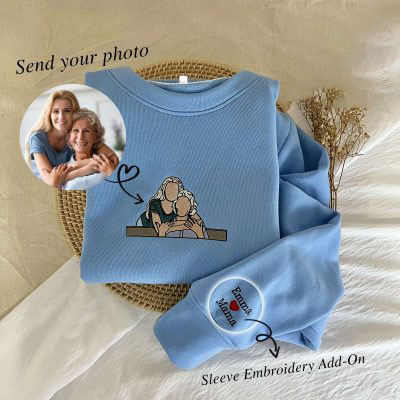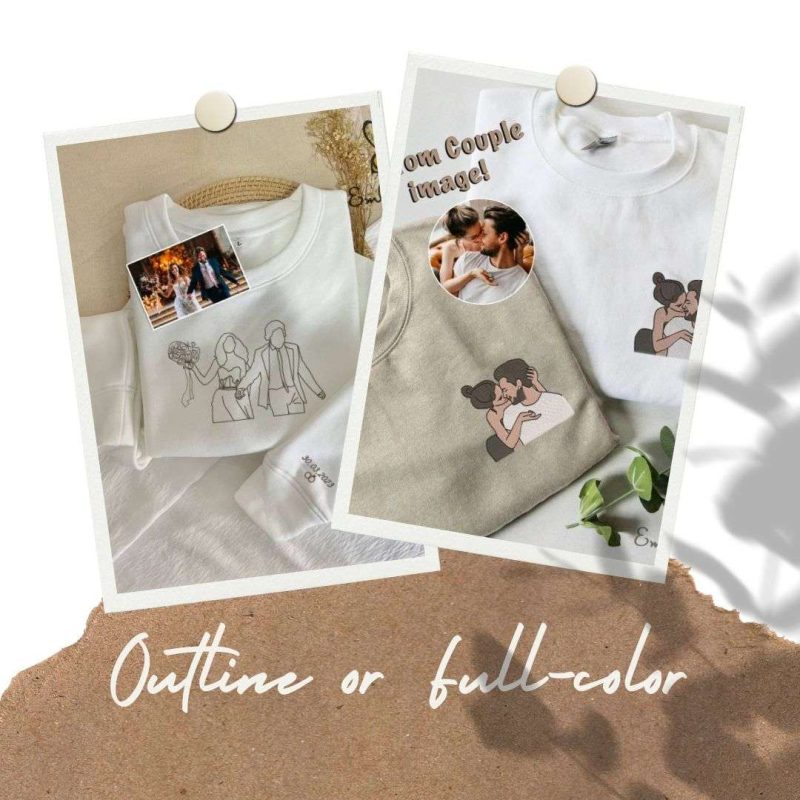Custom embroidery portrait is a type of art that involves stitching a portrait of a person or an animal onto a piece of fabric using a needle and thread. This technique involves creating a design that resembles a photograph or a painting, and then carefully embroidering the details onto the fabric. The result is a unique and personalized piece of art that captures your special moments or memories. However, there are two types of designs to choose from: outline and full-color embroidery portrait. In this post, we’ll explore these two types of portrait designs and help you decide which one is best for your needs and preferences
Outline Embroidery Portrait
What is Outline Embroidery Portrait?
Outline embroidery portrait is a type of embroidery that involves creating a portrait of a person or animal using only outlines. This portrait is typically done in a single color of thread, with the outlines forming the basic features and contours of the subject’s face, body, and clothing.
The process of creating an outline embroidery portrait usually involves transferring a drawing or photograph of the subject onto fabric, then stitching the outlines of the image using a variety of embroidery stitches such as backstitch, stem stitch, or chain stitch. By using different types of stitches and varying the thickness and spacing of the lines, embroiderers can create different effects and textures in their work.

Highlight Characteristics for Outline Embroidery Portrait
- Simplicity: Outline embroidery portraits are characterized by their simple use of lines and shapes to create an image, making them easy to recognize and appreciate.
- Elegance: Despite their simplicity, outline embroidery portraits can be incredibly elegant, thanks to the clean lines and negative space that create a sophisticated and refined aesthetic.
- Expressiveness: Although they do not include many details, outline embroidery portraits can still convey a lot of emotion and personality, capturing the essential features of a person or animal to create a striking and meaningful image.
- Time-saving: Compared to traditional embroidery techniques, outline embroidery portraits are faster and easier to create since they require only a single stitch to make the design.
Drawbacks of Outline Embroidery Portrait
- Limited Detail: The most significant challenge of creating outline embroidery portraits is the limited detail. Since the technique only involves stitching the outline or contour of the subject, capturing intricate features like facial expressions, hair details, or fine textures can be difficult.
- Pattern Creation: Creating a pattern for outline embroidery portraits can be challenging as it involves simplifying the subject into a simplified line drawing. Translating a photo or image into a simple line drawing that accurately captures the subject’s likeness requires a certain level of creativity and technical skill.
- Limited Color Options: Since the technique only involves a single stitch and thread color, the color options for the design can be limited. This may not be suitable for those looking for a design with more color or shading variations.
- Size Limitations: Since outline embroidery portraits rely on a simplified design, creating a very large design may not be as effective as a smaller one. The larger the design, the more complex it becomes, which can make it harder to capture the subject’s likeness.
- Limited Texture: The simplified style of outline embroidery portraits means that fine details and textures may not be well-represented in the design. This may not be suitable for those looking for a design that captures the subject’s texture or fabric in great detail.
It is important to consider these potential cons when deciding if outline embroidery portraits are suitable for a particular project or design.
Full-color Embroidery Portrait
What is Full-color Embroidery Portrait
Full-color embroidery portraits, also known as full-color digitized embroidery or photo-realistic embroidery, are a type of embroidery technique that allows for the creation of highly detailed and realistic images using multiple thread colors. This technique involves using specialized embroidery software to convert a digital image or photograph into a file format that can be read by an embroidery machine.
To create a full-color embroidery portrait, the digital image or photograph is first converted into a digital embroidery file. The embroidery file contains information about the colors and stitching required to create the design. The embroidery machine then reads the file and stitches the design onto the fabric, layering different colors of thread to create the final image.

Highlight Characteristics for Full-color Embroidery Portrait
- Realism: Full-color embroidery portraits are highly detailed and can create a realistic representation of the subject. By using a variety of thread colors and stitching techniques, the design can capture the subject’s likeness and personality in a way that is recognizable and true to life.
- Color Accuracy: Full-color embroidery portraits use multiple thread colors to create a wide range of colors and shades. This allows for a high level of color accuracy and shading, resulting in a dynamic and detailed final design. It also allows for greater creativity and artistic expression, as the artist can use different shades and colors to create depth and texture in the design.
- Attention to Detail: Full-color embroidery portraits require a high level of attention to detail in order to create an accurate and realistic representation of the subject. This includes paying close attention to the subject’s features, such as their facial expressions and clothing details, and replicating them with precision and accuracy.
- Textural Interest: Full-color embroidery portraits can add textural interest to clothing or other items, creating a tactile and visually interesting design. By using different types of stitches and thread textures, the artist can create a three-dimensional effect that adds depth and interest to the final design.
- Emotional Connection: Full-color embroidery portraits can create an emotional connection with the subject, making them a meaningful and cherished gift or item. By capturing the subject’s likeness and personality, the design can evoke a strong emotional response from the viewer and create a lasting impression. This is particularly true when the design is a portrait of a loved one or a special memory.
Drawbacks of Full-color Embroidery Portrait
- Cost: Full-color embroidery portraits can be more expensive than other forms of embroidery or decoration because they require more thread colors and a higher level of skill and attention to detail. Additionally, the cost of the materials used in full-color embroidery can be higher due to the increased amount of thread used.
- Time-Consuming: Full-color embroidery portraits can be time-consuming to create, as they require a high level of precision and attention to detail. This can be a drawback for those who need a design created quickly, as full-color embroidery portraits may take longer to complete than other forms of embroidery or decoration.
- Limited Fabric Choices: Full-color embroidery portraits are best suited for certain types of fabric, such as smooth and tightly woven fabrics. This can limit the options for creating a full-color embroidery design on certain materials, such as knits or loosely woven fabrics.
- Complexity: Full-color embroidery portraits can be more complex and difficult to create than other forms of embroidery or decoration, requiring a high level of skill and expertise. This can be a drawback for those who are new to embroidery or do not have the necessary skills or tools to create a full-color design. The intricacy of the design can also make it more difficult to make changes or corrections to the embroidery if necessary.
Factors to Consider When Choosing a Design
When deciding custom embroidery portrait, there are several factors to consider between outline and full-color embroidery portrait
- Complexity of the design: The complexity of the design can play a significant role in determining whether to use outline or full-color embroidery. If the design is simple and does not require many details, outline embroidery may be a suitable option. However, if the design is complex and requires intricate shading and color blending, full-color embroidery may be a better choice.
- Purpose of the embroidery: The purpose of the embroidery can also influence the choice between outline and full-color embroidery. For example, if the embroidery is for a professional setting, such as a business logo or a company uniform, a simple and clean outline embroidery may be more appropriate. However, if the embroidery is for a personal gift, such as a family portrait, full-color embroidery may be more meaningful and attractive.
- Time and cost: Full-color embroidery is generally more time-consuming and expensive than outline embroidery. Therefore, if time and cost are significant factors, outline embroidery may be a better option as it can be completed more quickly and at a lower cost.
- Material and color of the fabric: The material and color of the fabric can also influence the choice between outline and full-color embroidery. For example, if the fabric is dark-colored, full-color embroidery may not show up as well, and outline embroidery may be a better option. On the other hand, if the fabric is light-colored, full-color embroidery may be more vibrant and eye-catching.
- Size of the embroidery: The size of the embroidery can also influence the choice between outline and full-color embroidery. If the embroidery is small, it may be difficult to achieve the level of detail required for full-color embroidery, and outline embroidery may be a better option. On the other hand, if the embroidery is large, full-color embroidery may be more appropriate to create a more realistic and detailed portrait.
- Type of image: The type of image being embroidered can also influence the choice between outline and full-color embroidery. For example, if the image is a photograph with a lot of different colors and shades, full-color embroidery may be a better option. However, if the image is a simpler drawing with bold lines, outline embroidery may be more appropriate.
- Level of customization: Full-color embroidery allows for more customization options, such as different color shades and blending techniques. However, if you is satisfied with a more standard design, outline embroidery may be a more affordable and suitable option.
- Personal preference: Ultimately, personal preference can also play a role in the choice between outline and full-color embroidery. Some people may prefer the simplicity and elegance of outline embroidery, while others may prefer the bold and vivid colors of full-color embroidery.
In conclusion, choosing between outline and full-color embroidery portrait designs depends on your personal preferences and needs. Outline embroidery portraits are simple, elegant, and can convey emotion and personality, but may be limited in detail, color options, and texture. On the other hand, full-color embroidery portraits offer high levels of realism, color accuracy, attention to detail, textural interest, and emotional connection, but require specialized software and may be more time-consuming and expensive.




